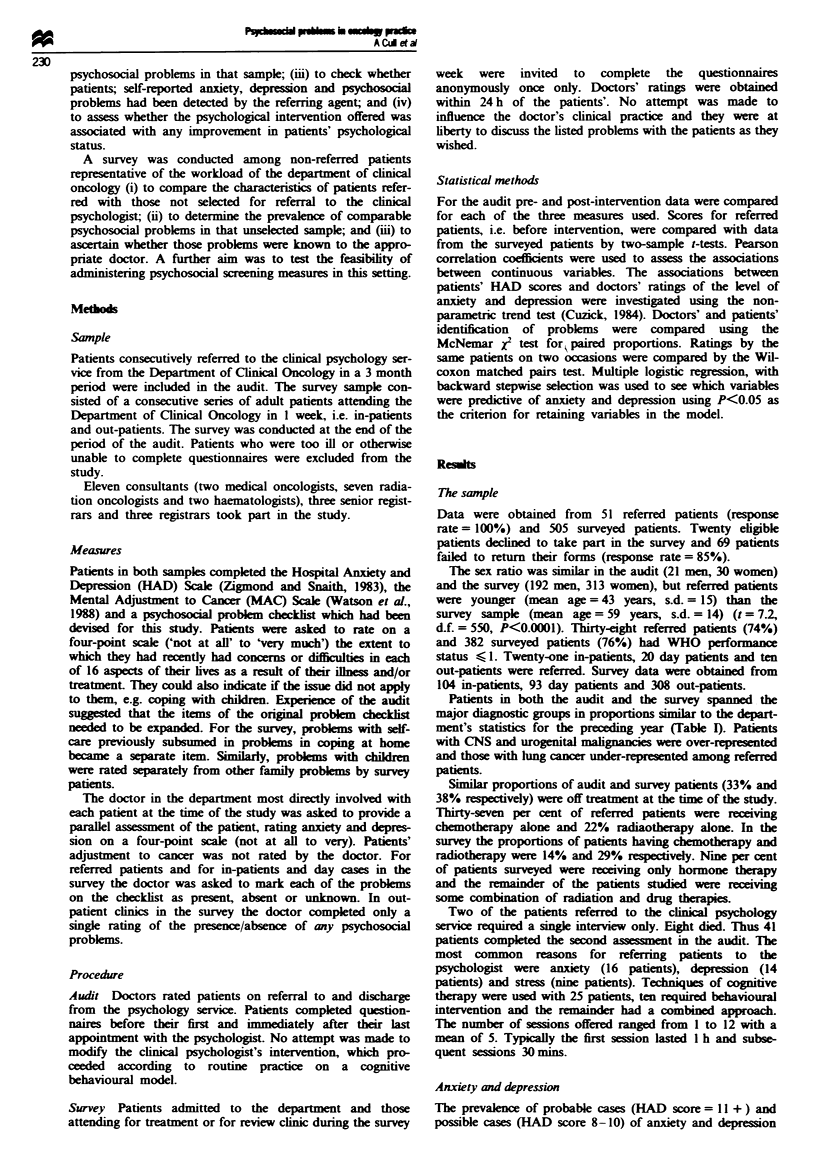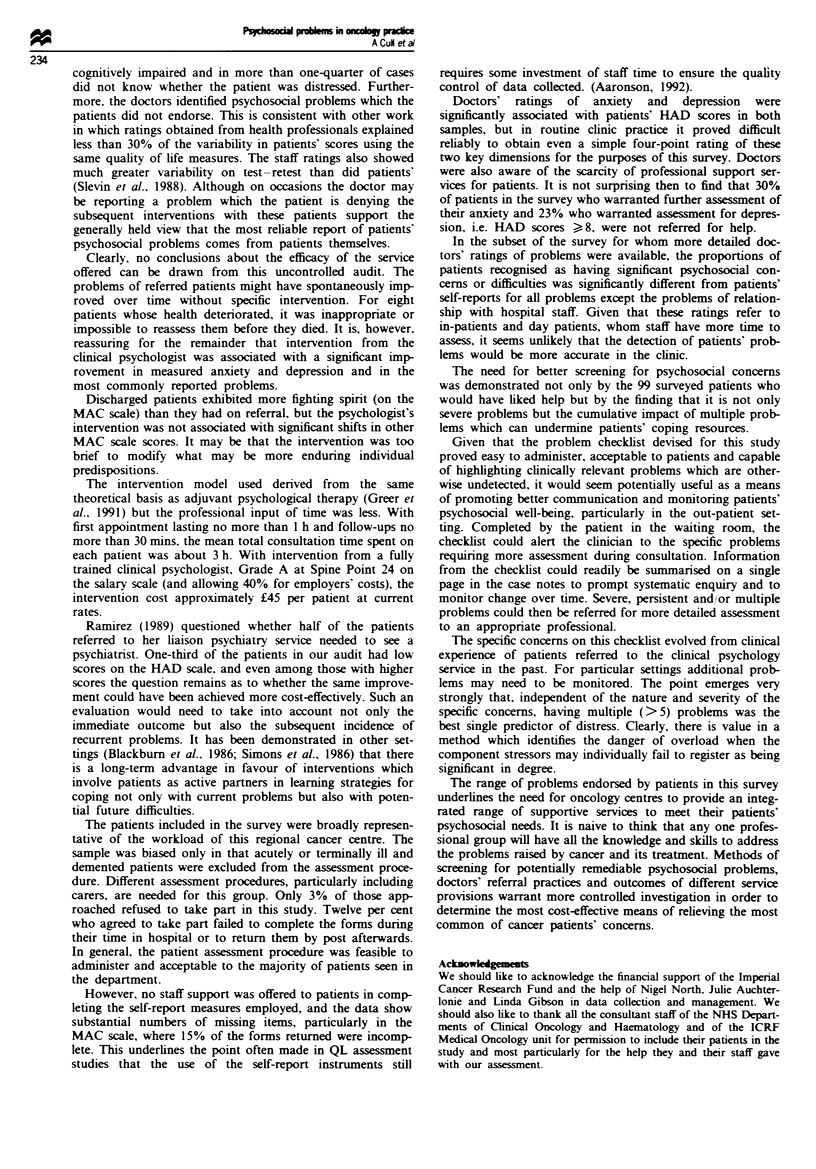Abstract
An audit was carried out of 51 oncology patients referred to a clinical psychology service to identify the characteristics of patients selected for referral and to assess change following psychological intervention. A survey was conducted of an unselected sample of oncology patients representative of the workload of the oncology department from which the referrals came, to determine the prevalence of comparable psychosocial problems among patients who were not referred for help and to assess whether doctors were aware of the problems patients reported. Data were collected using the Hospital Anxiety and Depression (HAD) and Mental Adjustment to Cancer (MAC) scales and a problem checklist devised for this study. Referred patients were significantly more anxious and depressed (P < 0.001) and showed poorer adjustment on MAC scales than the surveyed sample, but 30% of the latter group warranted assessment for anxiety and 23% for depression. The number of psychosocial problems of their severity. Intervention was clinically significant mood disorder irrespective of the specific problems of their severity. Intervention was associated with a significant improvement in distress and problems for referred patients by the time of discharge. Psychosocial problems were often undetected by staff even in referred patients. The checklist is a feasible screening method for potentially remediable problems which are cumulatively a significant contributor to cancer patients' distress.
Full text
PDF






Selected References
These references are in PubMed. This may not be the complete list of references from this article.
- Aaronson N. K. Assessing the quality of life of patients in cancer clinical trials: Common problems and common sense solutions. Eur J Cancer. 1992;28A(8-9):1304–1307. doi: 10.1016/0959-8049(92)90504-u. [DOI] [PubMed] [Google Scholar]
- Blackburn I. M., Eunson K. M., Bishop S. A two-year naturalistic follow-up of depressed patients treated with cognitive therapy, pharmacotherapy and a combination of both. J Affect Disord. 1986 Jan-Feb;10(1):67–75. doi: 10.1016/0165-0327(86)90050-9. [DOI] [PubMed] [Google Scholar]
- Christ G. H. A model for the development of psychosocial interventions. Recent Results Cancer Res. 1991;121:301–312. doi: 10.1007/978-3-642-84138-5_36. [DOI] [PubMed] [Google Scholar]
- Cuzick J. A Wilcoxon-type test for trend. Stat Med. 1985 Jan-Mar;4(1):87–90. doi: 10.1002/sim.4780040112. [DOI] [PubMed] [Google Scholar]
- Fallowfield L. J. Counselling and communication in oncology. Br J Cancer. 1991 Apr;63(4):481–482. doi: 10.1038/bjc.1991.114. [DOI] [PMC free article] [PubMed] [Google Scholar]
- Greer S., Moorey S., Baruch J. Evaluation of adjuvant psychological therapy for clinically referred cancer patients. Br J Cancer. 1991 Feb;63(2):257–260. doi: 10.1038/bjc.1991.60. [DOI] [PMC free article] [PubMed] [Google Scholar]
- Maguire P. Improving the detection of psychiatric problems in cancer patients. Soc Sci Med. 1985;20(8):819–823. doi: 10.1016/0277-9536(85)90336-3. [DOI] [PubMed] [Google Scholar]
- Osoba D. Self-rating symptom checklists: a simple method for recording and evaluating symptom control in oncology. Cancer Treat Rev. 1993;19 (Suppl A):43–51. doi: 10.1016/0305-7372(93)90056-w. [DOI] [PubMed] [Google Scholar]
- Ramirez A. J. Liaison psychiatry in a breast cancer unit. J R Soc Med. 1989 Jan;82(1):15–17. doi: 10.1177/014107688908200106. [DOI] [PMC free article] [PubMed] [Google Scholar]
- Schag C. A., Ganz P. A., Heinrich R. L. CAncer Rehabilitation Evaluation System--short form (CARES-SF). A cancer specific rehabilitation and quality of life instrument. Cancer. 1991 Sep 15;68(6):1406–1413. doi: 10.1002/1097-0142(19910915)68:6<1406::aid-cncr2820680638>3.0.co;2-2. [DOI] [PubMed] [Google Scholar]
- Slevin M. L., Plant H., Lynch D., Drinkwater J., Gregory W. M. Who should measure quality of life, the doctor or the patient? Br J Cancer. 1988 Jan;57(1):109–112. doi: 10.1038/bjc.1988.20. [DOI] [PMC free article] [PubMed] [Google Scholar]
- Watson M., Greer S., Young J., Inayat Q., Burgess C., Robertson B. Development of a questionnaire measure of adjustment to cancer: the MAC scale. Psychol Med. 1988 Feb;18(1):203–209. doi: 10.1017/s0033291700002026. [DOI] [PubMed] [Google Scholar]
- Zigmond A. S., Snaith R. P. The hospital anxiety and depression scale. Acta Psychiatr Scand. 1983 Jun;67(6):361–370. doi: 10.1111/j.1600-0447.1983.tb09716.x. [DOI] [PubMed] [Google Scholar]


